Evga- Geforce Gtx 1060 6gb 6gb Sc Gaming Review
Nvidia GeForce GTX 1060 Graphics Card Roundup
EVGA GeForce GTX 1060 SC Gaming
With the 6GB GeForce GTX 1060 SC Gaming, EVGA added a model that roughly follows Nvidia's reference design, but uses a cooler that eliminates the Founders Edition's overhangs. This gives u.s. a much shorter card seemingly ideal for HTPCs.
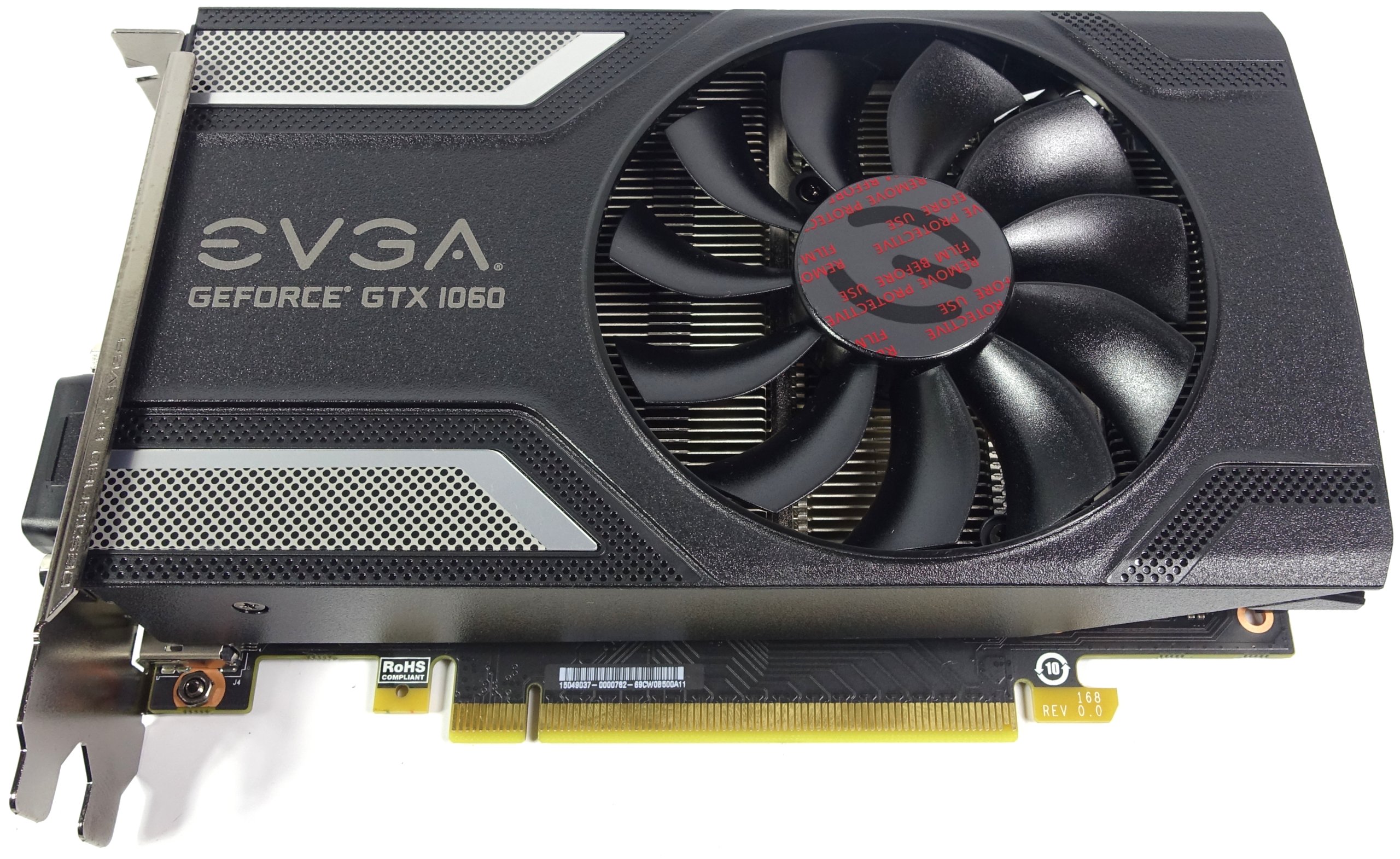
This model has some small weaknesses, though. Nosotros've already discussed them with EVGA, and the company plainly plans to update its BIOS afterward checking information technology with Nvidia. Improved VRM cooling is on the table as well. However, since EVGA allows customers to change its cooler, you tin apply our suggested modifications in a few manual steps without voiding the card's warranty.
Technical Specifications
More: Best Graphics Cards
More than: Desktop GPU Operation Hierarchy Table
MORE: All Graphics Content
Outside & Interfaces
The cooler cover is a depression-cost affair fabricated of anthracite-grey plastic and devoid of gaudy extras. Perhaps that's a plus. In meaty cases, the menu probably won't be visible anyways. Functional and affordable are interesting attributes in their own right.
Measuring just seven¼ inches (18.4cm) long from the slot comprehend, 4 1/v inches (10.5cm) tall from the superlative edge of the motherboard slot, 1 3/eight inches deep, and weighing just 20 ounces (576g), the GeForce GTX 1060 SC Gaming comes across every bit a light-weight dwarf. And if space if your chassis is notwithstanding an issue, information technology's easy to cut another third of an inch off the shroud if y'all take the correct tools.
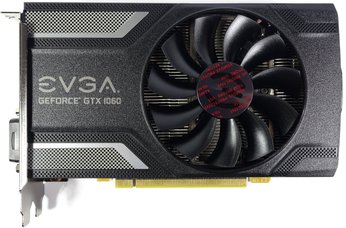
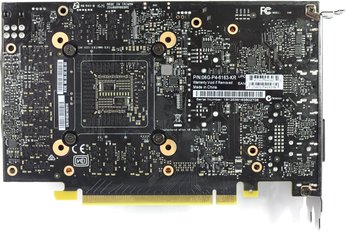
EVGA also abstained from attaching a backplate for reasons of price efficiency, which frees upwardly roughly one-fifth of an inch (5mm) for the CPU cooler in a mini-ITX enclosure. Sometimes that's the difference betwixt success and failure in a meaty build.

At that place's an EVGA logo up top, only information technology isn't back-lit. Moreover, a elementary 6-pin power connector sits at the end of the card and is not rotated.
A closer look at the bottom shows that, in spite of the carte's compact pattern, EVGA employed a heat pipe-based cooling solution anyway. Our upcoming measurements speak to the wisdom of that decision.

Horizontally-aligned fins help some of the GPU'southward waste heat escape out the slot cover, which is fairly free-flowing thanks to a number of holes cut into information technology. This principle is also credible at the finish of the card, where hot air dumps out into the middle of your case. Expert circulation is critical as a upshot.
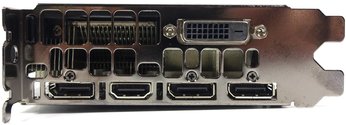
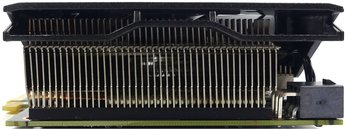
The slot cover exposes five outputs, four of which can be used simultaneously to drive multi-monitor configurations. In add-on to ane dual-link DVI output (which lacks an analog signal), you lot also go one HDMI 2.0 interface and three DisplayPort ane.iv-capable connectors.
Lath & Components
EVGA'south PCB is similar to Nvidia's reference design, but even so unique in item. For instance, while the GeForce GTX 1060 Founders Edition is manufactured in China, EVGA relies on a Taiwanese supplier.
Correct off the bat we see 4 ability phases, just like Nvidia's card. Three are meant for the GPU and one corresponds to the memory. Two of the three GPU phases are fed by the auxiliary power connector. The 3rd GPU phase and the 1 for the memory get power from the motherboard slot.
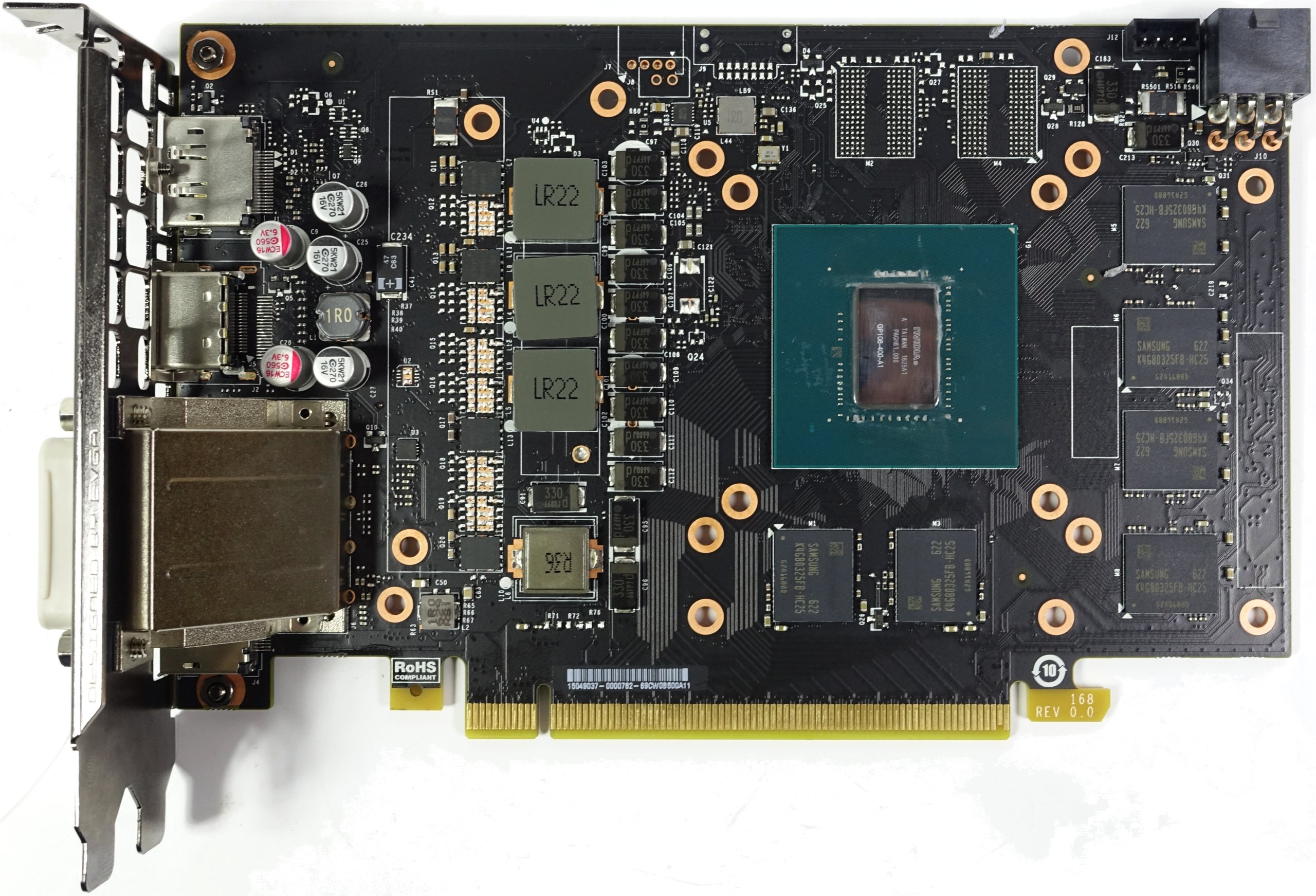
In theory, the PCB could accept enabled 3 phases and a maximum of half dozen regulator circuits via doubling for the GPU, plus one phase for the memory. However, this minimalist configuration with just one regulator circuit per stage, like to Nvidia's reference design, seems to be more than popular given its lower toll.
The three GPU phases are controlled using one uPI Semiconductor uP9505P, with each regulator circuit realized as a highly integrated E6930 Dual N-Channel MOSFET, which combines the gate driver, high- and depression-side MOSFET, and Schottky-diode in one user-friendly package.
Over again, this is meant to cut costs and conserve space. But concentrating all of the components in 1 parcel also comes with a significant disadvantage: the cosmos of thermal hot-spots. This is made worse by the fact that two of these MOSFETS are positioned fairly close to each other. Since the PCB was designed to facilitate doubling, one of the two MOSFETS could have been moved into the 2nd regulator circuit's vacant space.
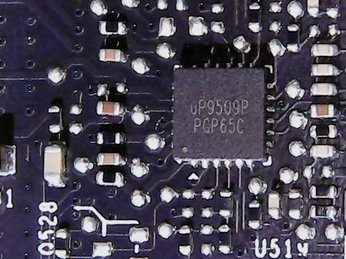
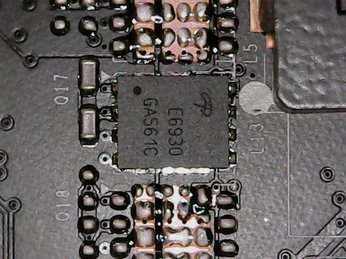
Two capacitors are installed right below the GPU to absorb and equalize voltage peaks.
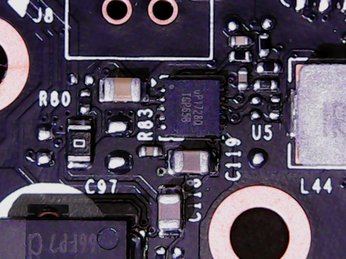

Just 6 of the 8 bachelor memory emplacements are populated with Samsung K4G80325FB-HC25 modules. Each one adds 8Gb (32x256Mb) and operates at voltages between 1.305 and 1.597V, depending on clock rate. In total, they add together up to the GeForce GTX 1060 SC Gaming'southward 6GB of GDDR5.
Power Results
A compact graphics menu typically enjoys less thermal headroom due to its smaller libation. Naturally, we want to track the correlation between clock rate and voltage.
The data shows usa that frequency drops slightly as the card heats up during a gaming session.
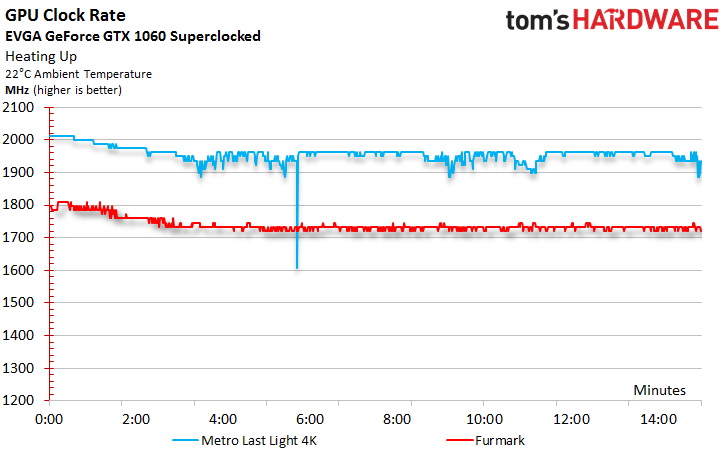
The 2012 MHz GPU Boost frequency we initially mensurate falls to 1949-1962 MHz under load. Voltage behaves similarly: later on commencement measuring 1.062V, that value dropped to 0.975V on boilerplate after warming up (the actual range was 1.025 to 0.9V). All of this points back to GPU Boost 3.0 and a relatively low power target that limits consumption to merely over 120W.
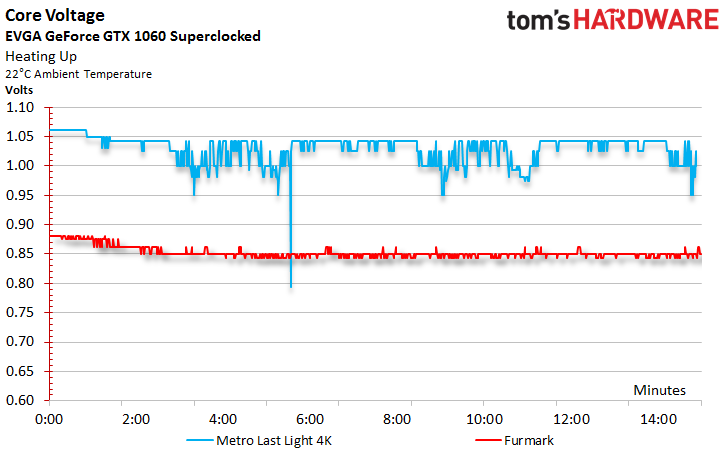
The lowest GPU clock charge per unit measured with an idle card was about 253 MHz, and at that frequency, power consumption was similar to Nvidia's reference pattern.
Nosotros took our measurements using a variable depression-laissez passer filter, and so we mention short load peaks only every bit a side note (see the grayed-out bar in the chart below), since those peaks are rarely relevant in do. Nevertheless, that value is quite high, hinting at less than optimal chief-side smoothing prior to the voltage regulators.
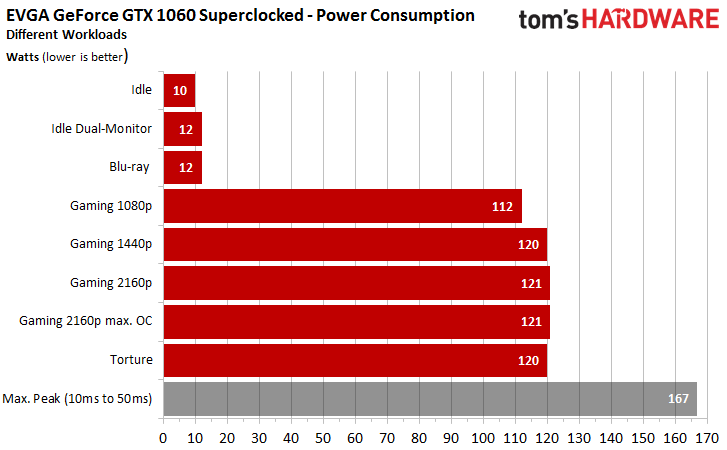
A low power target causes GPU Boost to cut the voltages dramatically during our stress test, resulting in power consumption numbers that are lower than what we measure during a worst-case gaming workload.
Power Connector Load
Load distribution from the four voltage regulators to their respective ability phases isn't problematic at all. However, there's little headroom for overclocking, even if it wasn't already limited past the firmware's power target and voltage settings.
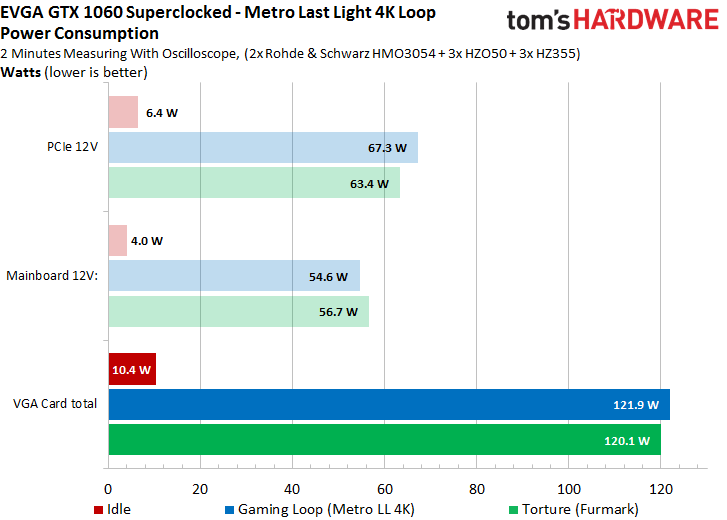
Here'south the data for the gaming and stress tests:
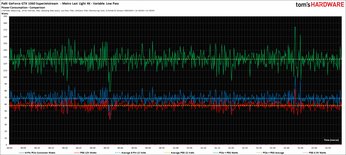

Power consumption on its own only tells the states part of the story. The PCI-SIG specifies a maximum of 5.5A at the motherboard slot, and we're showing a reading under 5A, which puts EVGA's GeForce GTX 1060 SC Gaming in the green.
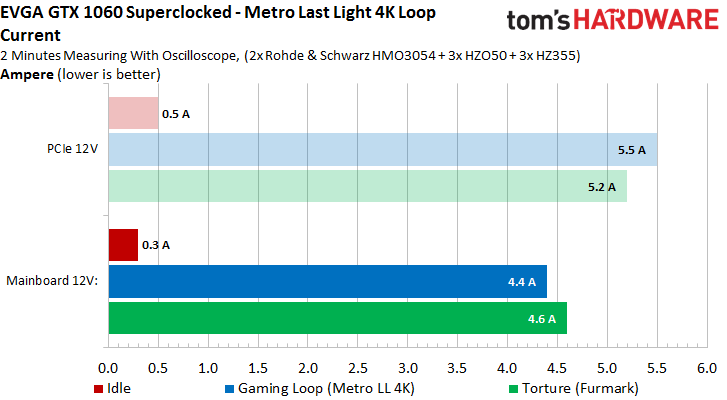
Of course, nosotros have the data for measured currents too:

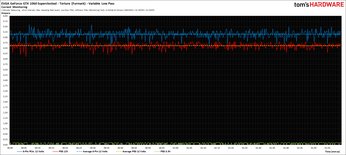
The Cooler, Its Operation & A Elementary Mod
Fortunately, the headaches acquired by EVGA's cooler can be improved in just a few steps. Since the company does permit removal of its thermal solution without voiding the carte'south warranty, we can describe our modification in detail and encourage you to endeavour it yourself. As long as EVGA doesn't implement changes of its own to augment performance, this procedure is worthwhile.
Once the four screws holding the cooler above the GPU package are removed and the cooler lifted off, two flat 8mm rut pipes go visible. They're meant to misemploy heat from the copper sink to the fins on both ends of the cooler. Their composite material should be able to bargain with curvature and orientation in a reasonably efficient manner.
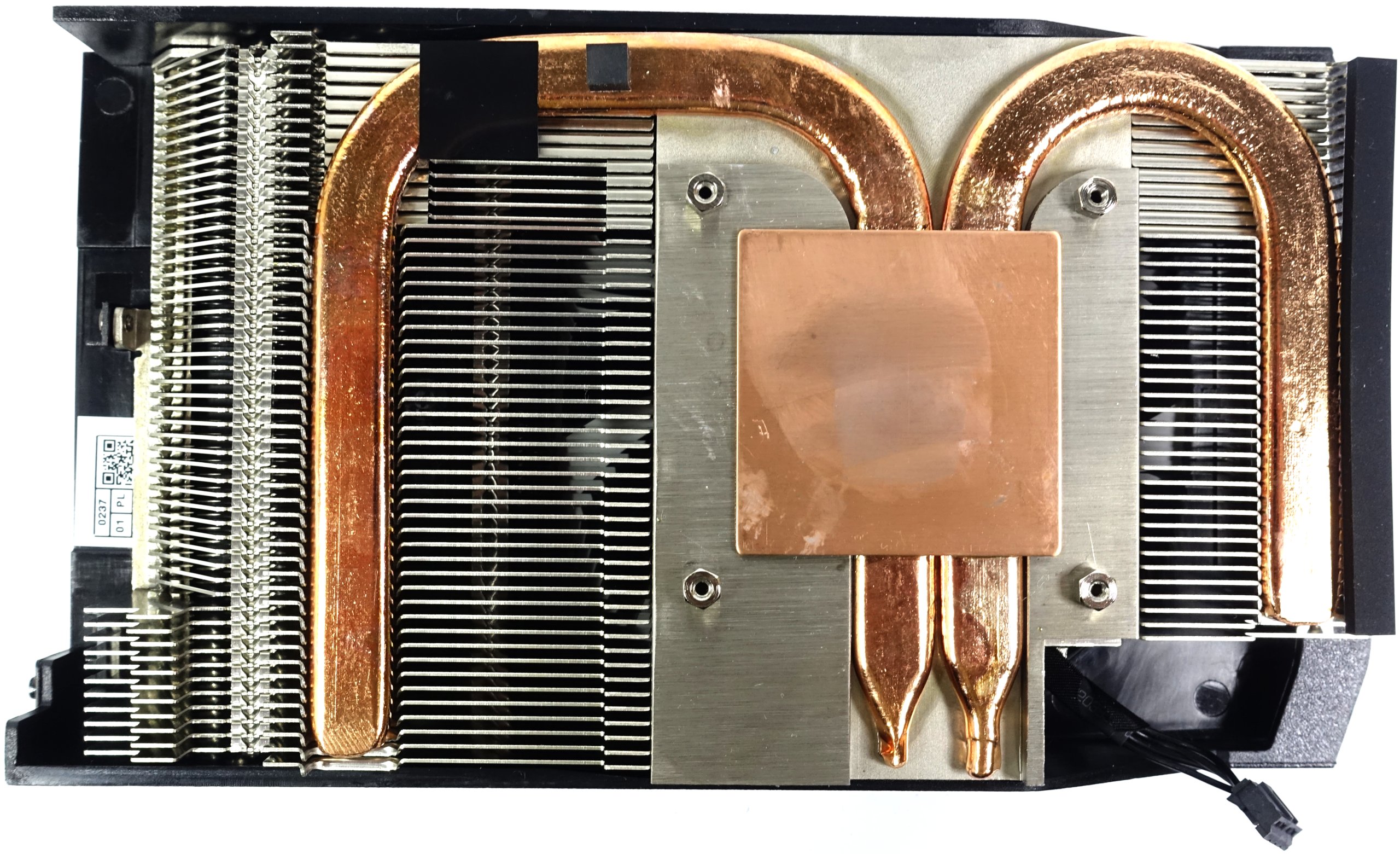
However, it'due south apparent that the VRM'south four dual-channel MOSFETs and the memory packages receive no active cooling. This is exactly where nosotros will employ our minor modification to affect big change with little endeavor.
The congenital-in 9cm fan relies on conventional rotor blades, which are quite steep to generate more force per unit area. Unfortunately, the heat pipes comprehend several important areas, such as the VRMs, pregnant little of that extra airflow actually reaches the PCB's surface.
As far as the GPU is concerned, we mensurate 163 to 165°F (73 to 74°C) during our gaming loop and a maximum of 172°F (78°C) in a closed case. When it comes to the processor itself, EVGA'due south cooler does a respectable job. The stress test reveals a more gradual ramp up due to a lower frequency and less power consumption. But the concluding temperatures are nearly identical.
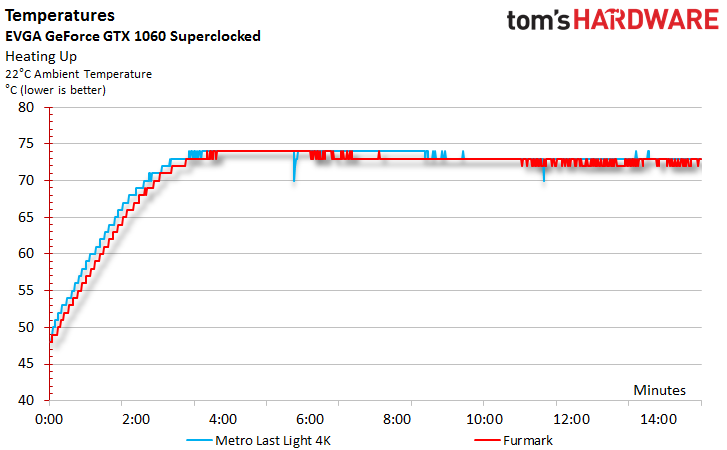
As our infrared readings demonstrate, though, a lack of active cooling on the VRMs has negative consequences. Fifty-fifty on an open test bench, temperatures during our gaming loop reach 234°F (112°C). Our stress test gets them up to 246°F (119°C). Although that sounds bad, it's not out of spec for the built-in MOSFETs, which are rated at upwardly to 302°F (150°C). Nonetheless, the backlog rut travels through the multi-layer circuit board's copper traces and spreads over a large expanse.
The PWM controller mounted on the back of the board (visible just right of the VRM label as a faint rectangle) measures approximately 221°F (105°C). Over again, this is within an acceptable range, since but temperatures as high as 302°F (150°C) would cease in an OTP-related close-down. We're more worried about the capacitors. Their through-pigsty leads work similar little antennas, effectively transporting heat within. With well over 212°F (100°C), and up to 234°F (112°C) during the stress test, this could lead to bug over time.
Later all, these measurements were taken in an air-conditioned room at 72°F (22°C). In the superlative of summer, smaller PC cases oestrus up considerably. The same readings nerveless nether less forgiving circumstances would probable plough out to be fifty-fifty higher.
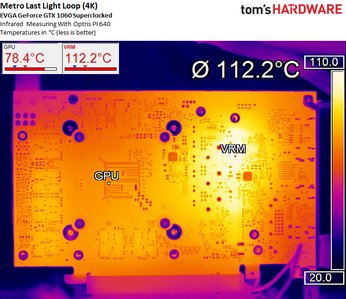
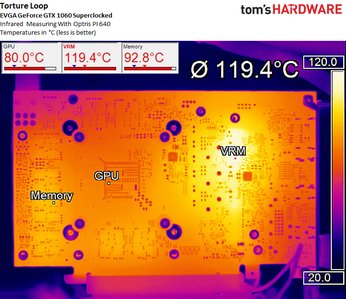
Furthermore, the fact that the circuit board simply below the GPU package is hotter than what the processor's own diode measures means the GPU is cooling the PCB, which is counterproductive. Nosotros do hope EVGA considers implementing something similar to our remedy.
A Safety Modification
The fact that the rut pipes cover the MOSFETs tin can hands be used as leverage. For the sake of simplicity, this example focuses exclusively on reducing the larger hot-spot of the two upper GPU VRMs by applying a stack of two thermal pads to bridge the 10th of an inch (ii.5mm) departure between them and the oestrus pipe. Of course, you'd want to gear up up all four MOSFETs similar this, yielding an even amend result.
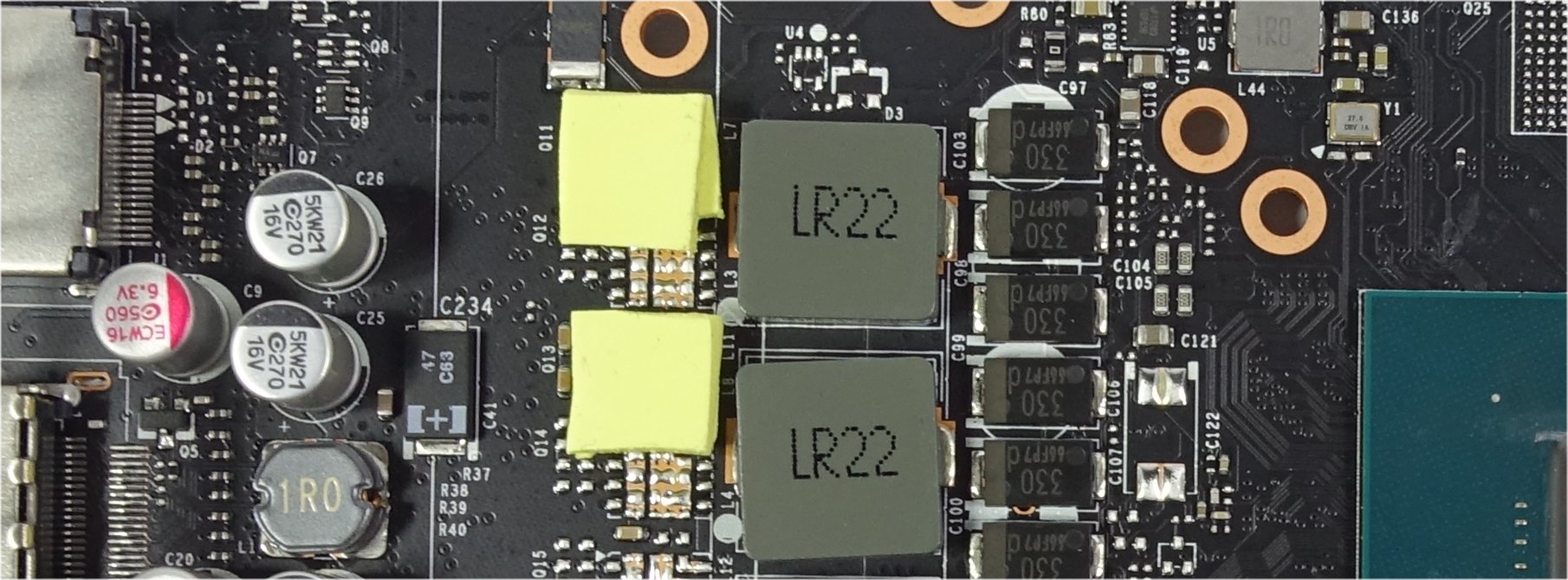
This superimposed image clearly shows the position of the heat pipes in relation to the components underneath, along with the position of our small cooling help.
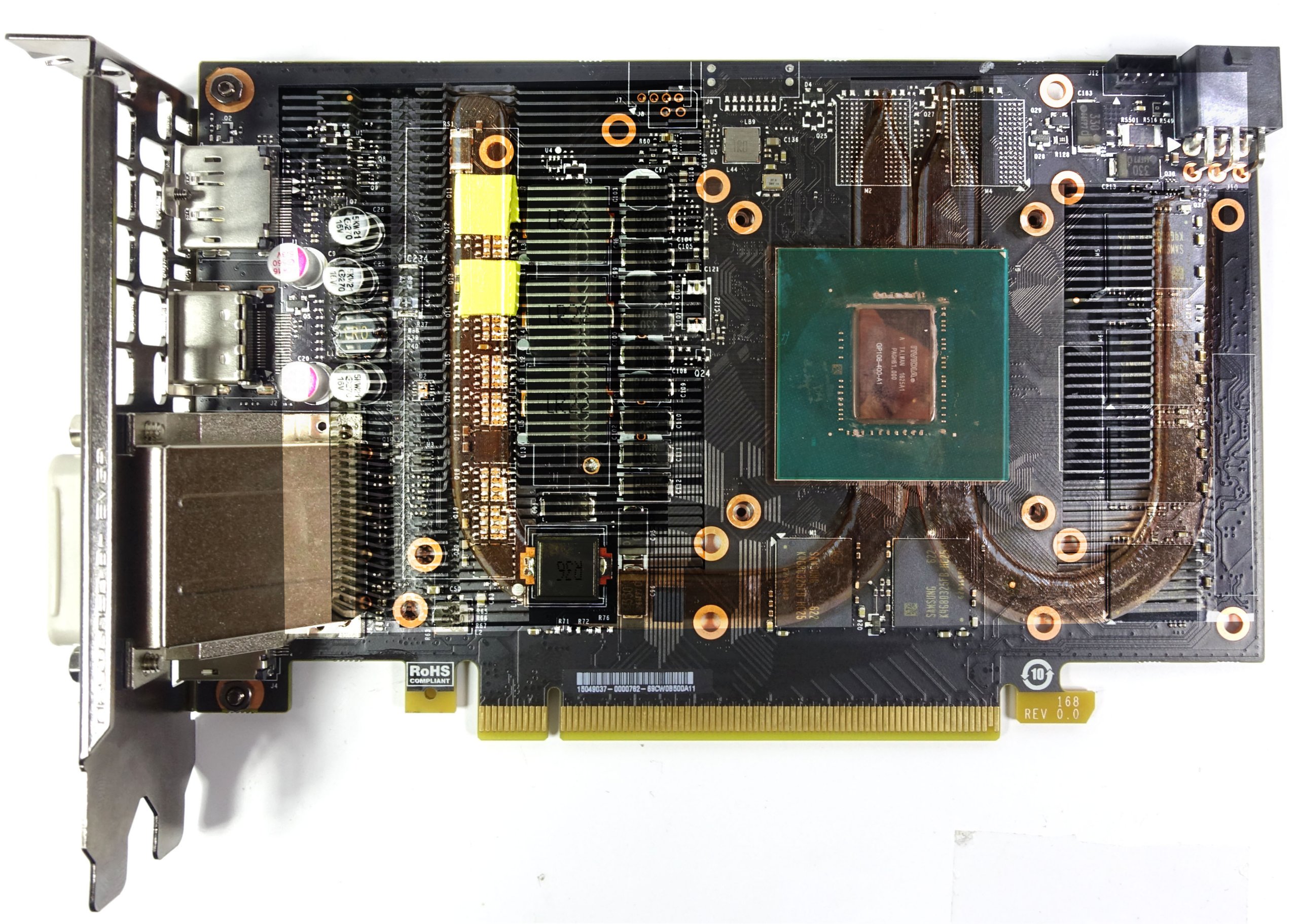
Retaking the measurement with an infrared camera left us amazed. Despite our meager investment and bones materials, the impact on cooling was astonishing. A reading vii to eight Kelvin lower for only two of the iv MOSFETs puts us in a temperature range that allows some confidence in long-term reliability, even in small cases.
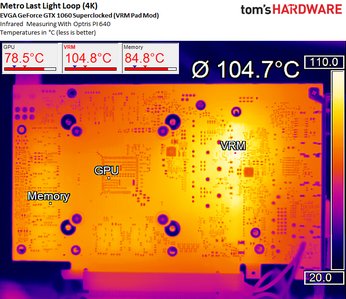

Audio Results
Hysteresis is not an outcome for most manufacturers, and EVGA typically fares well here. After applying the most recent BIOS update, the GeForce GTX 1060 SC Gaming's semi-passive mode worked well without any annoying start/cease cycles. The threshold at which the fan spins up is prepare to ~149°F (65°C), but the GPU's current load isn't taken into account.
It's possible to lower the GPU's temperature four or v Kelvin more by configuring a custom fan curve to give the card a bit of extra air (important for mini-ITX projects). That helps the GPU Heave clock rates, too.
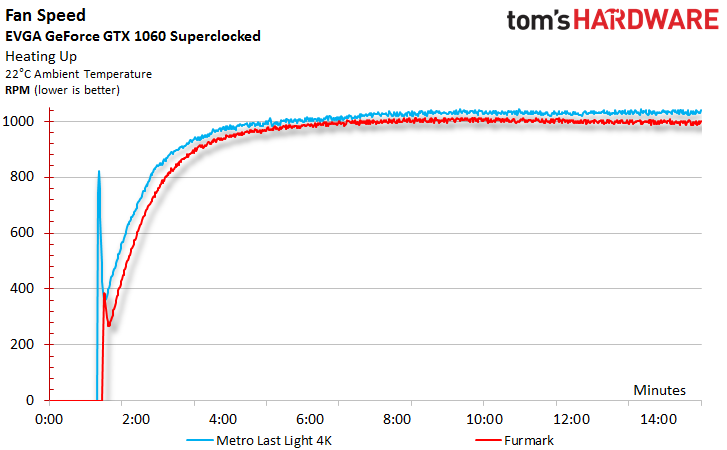
When the card is idle, noise is not measurable due to a semi-passive manner. A reading of 34.iii dB(A) under load is commendable, and that'due south primarily due to a conservative fan bend. However, fifty-fifty at 1300 RPM the dissonance level remains below the still-acceptable 36 dB(A) marker.
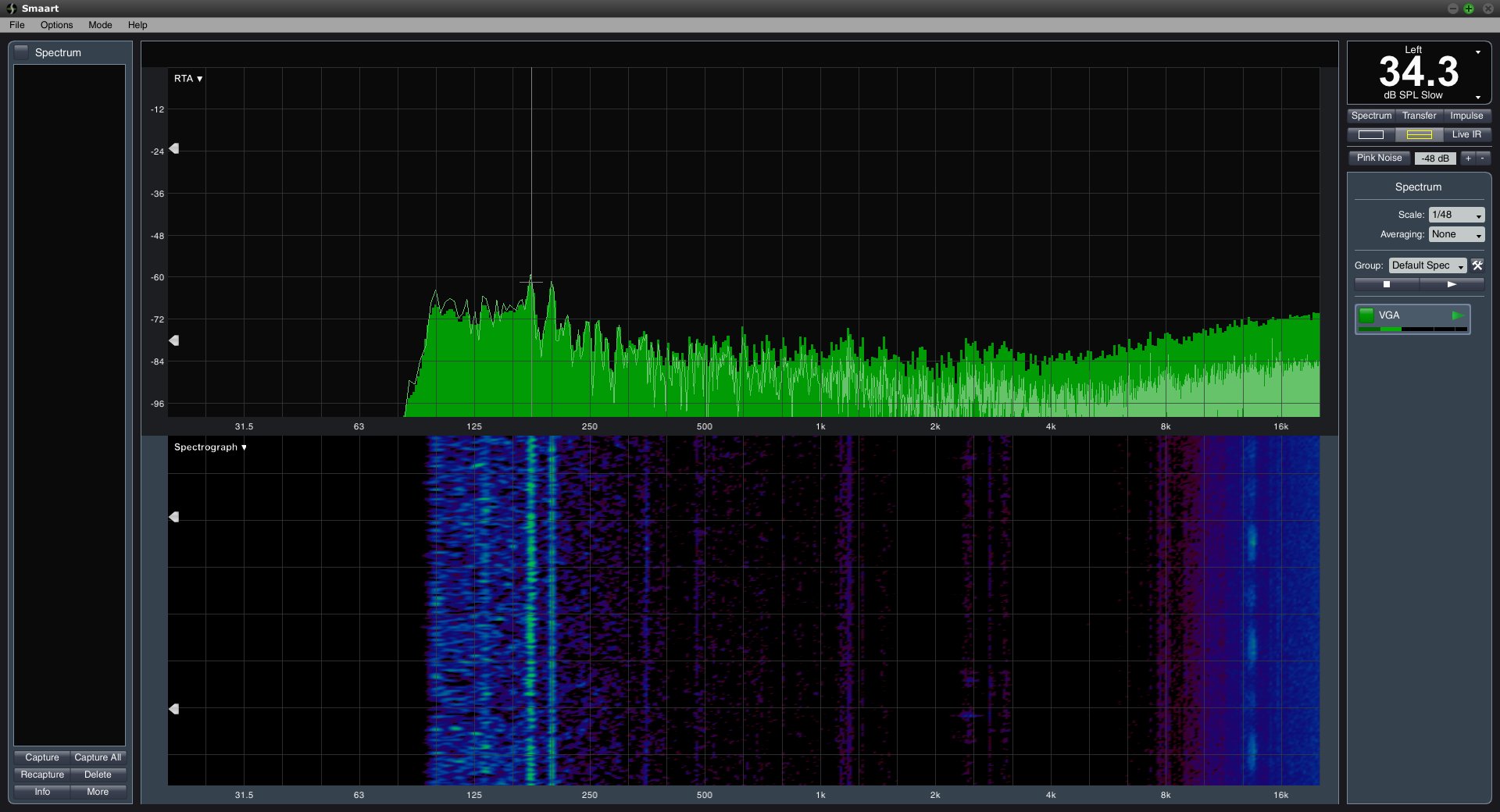

MORE: Nvidia GeForce GTX 1080 Roundup
More than: Nvidia GeForce GTX 1070 Roundup
More than: All Graphics Content
Source: https://www.tomshardware.com/reviews/nvidia-geforce-gtx-1060-graphics-card-roundup,4724-4.html
0 Response to "Evga- Geforce Gtx 1060 6gb 6gb Sc Gaming Review"
Post a Comment